On the Microstructure and Mechanical Properties of CrNx/Ag Multilayer Films Prepared by Magnetron Sputtering
Abstract
1. Introduction
2. Materials and Method
2.1. Deposition Tool and Substrate
2.2. Process of Films Preparation
2.3. Characterization of Films Morphology
2.4. Characterization of Composition and Microstructure
2.5. Characterization of Hardness
2.6. Characterization of Wear Properties
3. Results and Discussion
3.1. Microstructure
3.2. Mechanical Properties
4. Conclusions
Author Contributions
Funding
Conflicts of Interest
References
- Carvalho, I.; Curado, M.; Palacio, C.; Carvalho, S.; Cavaleiro, A. Ag release from sputtered Ag/a:C nanocomposite films after immersion in pure water and NaCl solution. Thin Solid Film 2019, 671, 85–94. [Google Scholar] [CrossRef]
- Dang, C.; Li, J.; Wang, Y.; Yang, Y.; Wang, Y.; Chen, J. Influence of Ag contents on structure and tribological properties of TiSiN-Ag nanocomposite coatings on Ti–6Al–4V. Appl. Surf. Sci. 2017, 394, 613–624. [Google Scholar] [CrossRef]
- Ren, P.; Zhang, K.; Wen, M.; Du, S.; Chen, J.; Zheng, W. The roles of Ag layers in regulating strengthening-toughening behavior and tribochemistry of the Ag/TaC nano-multilayer films. Appl. Surf. Sci. 2018, 445, 415–423. [Google Scholar] [CrossRef]
- Guo, H.; Han, M.; Chen, W.; Lu, C.; Li, B.; Wang, W.; Jia, J. Microstructure and properties of VN/Ag composite films with various silver content. Vacuum 2017, 137, 97–103. [Google Scholar] [CrossRef]
- Zhu, Y.; Dong, M.; Chang, K.; Li, J.; Wang, L. Prolonged anti-bacterial action by sluggish release of Ag from TiSiN/Ag multilayer coating. J. Alloy. Compd. 2019, 783, 164–172. [Google Scholar] [CrossRef]
- Aouadi, S.; Bohnhoff, A.; Sodergren, M.; Mihut, D.; Rohde, S.; Xu, J.; Mishra, S. Tribological investigation of zirconium nitride/silver nanocomposite structures. Surf. Coat. Technol. 2006, 201, 418–422. [Google Scholar] [CrossRef]
- Köstenbauer, H.; Fontalvo, G.A.; Mitterer, C.; Keckes, J. Tribological properties of TiN/Ag nanocomposite coatings. Tribol. Lett. 2008, 30, 53–60. [Google Scholar] [CrossRef]
- Mulligan, C.; Papi, P.; Gall, D. Ag transport in CrN-Ag nanocomposite coatings. Thin Solid Film 2012, 520, 6774–6779. [Google Scholar] [CrossRef]
- Mulligan, C.P.; Blanchet, T.A.; Gall, D. CrN-Ag nanocomposite coatings: Effect of growth temperature on the microstructure. Surf. Coat. Technol. 2008, 203, 584–587. [Google Scholar] [CrossRef]
- Mulligan, C.P.; Blanchet, T.A.; Gall, D. CrN-Ag nanocomposite coatings: Tribology at room temperature and during a temperature ramp. Surf. Coat. Technol. 2010, 204, 1388–1394. [Google Scholar] [CrossRef]
- Mulligan, C.P.; Blanchet, T.A.; Gall, D. CrN-Ag nanocomposite coatings: High-temperature tribological response. Wear 2010, 269, 125–131. [Google Scholar] [CrossRef]
- Mulligan, C.P.; Gall, D. CrN-Ag self-lubricating hard coatings. Surf. Coat. Technol. 2005, 200, 1495–1500. [Google Scholar] [CrossRef]
- Mulligan, C.; Blanchet, T.; Gall, D. Control of lubricant transport by a CrN diffusion barrier layer during high-temperature sliding of a CrN–Ag composite coating. Surf. Coat. Technol. 2010, 205, 1350–1355. [Google Scholar] [CrossRef]
- Yao, S.H.; Kao, W.H.; Su, Y.L.; Liu, T.H. Effect of periods on wear performance of TiN/AlN superlattice films. Mater. Sci. Eng. A 2005, 392, 380–385. [Google Scholar] [CrossRef]
- Berger, M.; Wiklund, U.; Eriksson, M.; Engqvist, H.; Jacobson, S. The multilayer effect in abrasion—Optimising the combination of hard and tough phases. Surf. Coat. Technol. 1999, 116, 1138–1144. [Google Scholar] [CrossRef]
- Braic, M.; Balaceanu, M.; Vladescu, A.; Zoita, C.; Braic, V. Study of (Zr, Ti) CN,(Zr, Hf) CN and (Zr, Nb) CN films prepared by reactive magnetron sputtering. Thin Solid Film 2011, 519, 4092–4096. [Google Scholar] [CrossRef]
- Gu, B.; Tu, J.P.; Zheng, X.H.; Yang, Y.Z.; Peng, S.M. Comparison in mechanical and tribological properties of Cr-W-N and Cr-Mo-N multilayer films deposited by DC reactive magnetron sputtering. Surf. Coat. Technol. 2008, 202, 2189–2193. [Google Scholar] [CrossRef]
- Liu, Z.; Xu, Y.; Peng, B.; Wei, W.; Chen, L.; Wang, Q. Structure and property optimization of Ni-containing AlCrSiN coatings by nano-multilayer construction. J. Alloy. Compd. 2019, 808, 151630. [Google Scholar] [CrossRef]
- Madan, A.; Barnett, S.A.; Misra, A.; Kung, H.; Nastasi, M. Structure, stability, and mechanical properties of epitaxial W/NbN superlattices. J. Vac. Sci. Technol. A 2001, 19, 952–957. [Google Scholar] [CrossRef]
- Baraket, M.; Mercs, D.; Zhang, Z.G.; Coddet, C. Mechanical and tribological properties of CrN/Ag and CrSiN/Ag nanoscale multilayers. Surf. Coat. Technol. 2010, 204, 2386–2391. [Google Scholar] [CrossRef]
- Yao, S.H.; Su, Y.L.; Kao, W.H.; Cheng, K.W.; Su, C.T. Performance of nanolayer CrN/Ag coated cutting tools. Surf. Eng. 2011, 27, 180–188. [Google Scholar] [CrossRef]
- Lin, J.L.; Moore, J.J.; Wang, J.; Sproul, W.D. High temperature oxidation behavior of CrN/AlN superlattice films. Thin Solid Film 2011, 519, 2402–2408. [Google Scholar] [CrossRef]
- Barata, A.; Cunha, L.; Moura, C. Characterisation of chromium nitride films produced by PVD techniques. Thin Solid Film 2001, 398, 501–506. [Google Scholar] [CrossRef]
- Djouadi, M.A.; Nouveau, C.; Beer, P.; Lambertin, M. CrxNy hard coatings deposited with PVD method on tools for wood machining. Surf. Coat. Technol. 2000, 133, 478–483. [Google Scholar] [CrossRef]
- Brown, A.; Linde, S. Powder diffraction profiles and the pearson VII distribution. Adv. X Ray Anal. 1986, 30, 343–350. [Google Scholar] [CrossRef]
- Scherrer, P. Bestimmung der Größe und der inneren Struktur von Kolloidteilchen mittels Röntgenstrahlen. Wiss. Göttingen 1918, 2, 98–100. [Google Scholar]
- Hones, P.; Sanjines, R.; Levy, F. Characterization of sputter-deposited chromium nitride thin films for hard coatings. Surf. Coat. Technol. 1997, 94, 398–402. [Google Scholar] [CrossRef]
- Dang, C.; Yao, Y.; Olugbade, T.; Li, J.; Wang, L. Effect of multi-interfacial structure on fracture resistance of composite TiSiN/Ag/TiSiN multilayer coating. Thin Solid Film 2018, 653, 107–112. [Google Scholar] [CrossRef]
- Jurči, P.; Bílek, P.; Podgornik, B. Cr2N0.62-11Ag adaptive nanocomposite thin films: Transport of Ag solid lubricant during annealing in a closed-air atmosphere. Thin Solid Film 2017, 639, 127–136. [Google Scholar] [CrossRef]
- Aouadi, S.; Shreeman, P.; Ge, Q.; Xu, J.; Mishra, S. Correlation between interfacial electronic structure and mechanical properties of ZrN–Me (Me = Ag, Au, or Pd) nanocomposite films. Appl. Phys. Lett. 2005, 87, 041902. [Google Scholar] [CrossRef]
- Grasser, S.; Daniel, R.; Mitterer, C. Microstructure modifications of CrN coatings by pulsed bias sputtering. Surf. Coat. Technol. 2012, 206, 4666–4671. [Google Scholar] [CrossRef]
- Nam, K.H.; Jung, M.J.; Han, J.G. A study on the high rate deposition of CrNx films with controlled microstructure by magnetron sputtering. Surf. Coat. Technol. 2000, 131, 222–227. [Google Scholar] [CrossRef]
- Hurkmans, T.; Lewis, D.; Brooks, J.; Münz, W.-D. Chromium nitride coatings grown by unbalanced magnetron (UBM) and combined arc/unbalanced magnetron (ABS™) deposition techniques. Surf. Coat. Technol. 1996, 86, 192–199. [Google Scholar] [CrossRef]
- Yu, J.G.; Sun, X.H.; Gong, H.H.; Dong, L.; Zhao, M.L.; Wan, R.X.; Gu, H.Q.; Li, D.J. Influence of Ag concentration on microstructure, mechanical properties and cytocompatibility of nanoscale Ti-Ag-N/Ag multilayers. Surf. Coat. Technol. 2017, 312, 128–133. [Google Scholar] [CrossRef]
- Li, G.; Lao, J.; Tian, J.; Han, Z.; Gu, M. Coherent growth and mechanical properties of AlN/VN multilayers. J. Appl. Phys. 2004, 95, 92–96. [Google Scholar] [CrossRef]
- Madan, A.; Wang, Y.Y.; Barnett, S.A.; Engstrom, C.; Ljungcrantz, H.; Hultman, L.; Grimsditch, M. Enhanced mechanical hardness in epitaxial nonisostructural Mo/NbN and W/NbN superlattices. J. Appl. Phys. 1998, 84, 776–785. [Google Scholar] [CrossRef]
- Bondarev, A.V.; Kiryukhantsev-Korneev, P.V.; Levashov, E.A.; Shtansky, D.V. Tribological behavior and self-healing functionality of TiNbCN-Ag coatings in wide temperature range. Appl. Surf. Sci. 2017, 396, 110–120. [Google Scholar] [CrossRef]
- Bondarev, A.V.; Golizadeh, M.; Shvyndina, N.V.; Shchetinin, I.V.; Shtansky, D.V. Microstructure, mechanical, and tribological properties of Ag-free and Ag-doped VCN coatings. Surf. Coat. Technol. 2017, 331, 77–84. [Google Scholar] [CrossRef]
- Incerti, L.; Rota, A.; Valeri, S.; Miguel, A.; García, J.A.; Rodríguez, R.J.; Osés, J. Nanostructured self-lubricating CrN-Ag films deposited by PVD arc discharge and magnetron sputtering. Vacuum 2011, 85, 1108–1113. [Google Scholar] [CrossRef]
- Chiodi, M.; Cancellieri, C.; Moszner, F.; Andrzejczuk, M.; Jeurgens, L.P.H. Massive Ag migration through metal/ceramic nano-multilayers: Interplay between temperature, stress-relaxation and oxygen-enhanced mass transport. J. Mater. Chem. C 2016, 4, 4927–4938. [Google Scholar] [CrossRef]


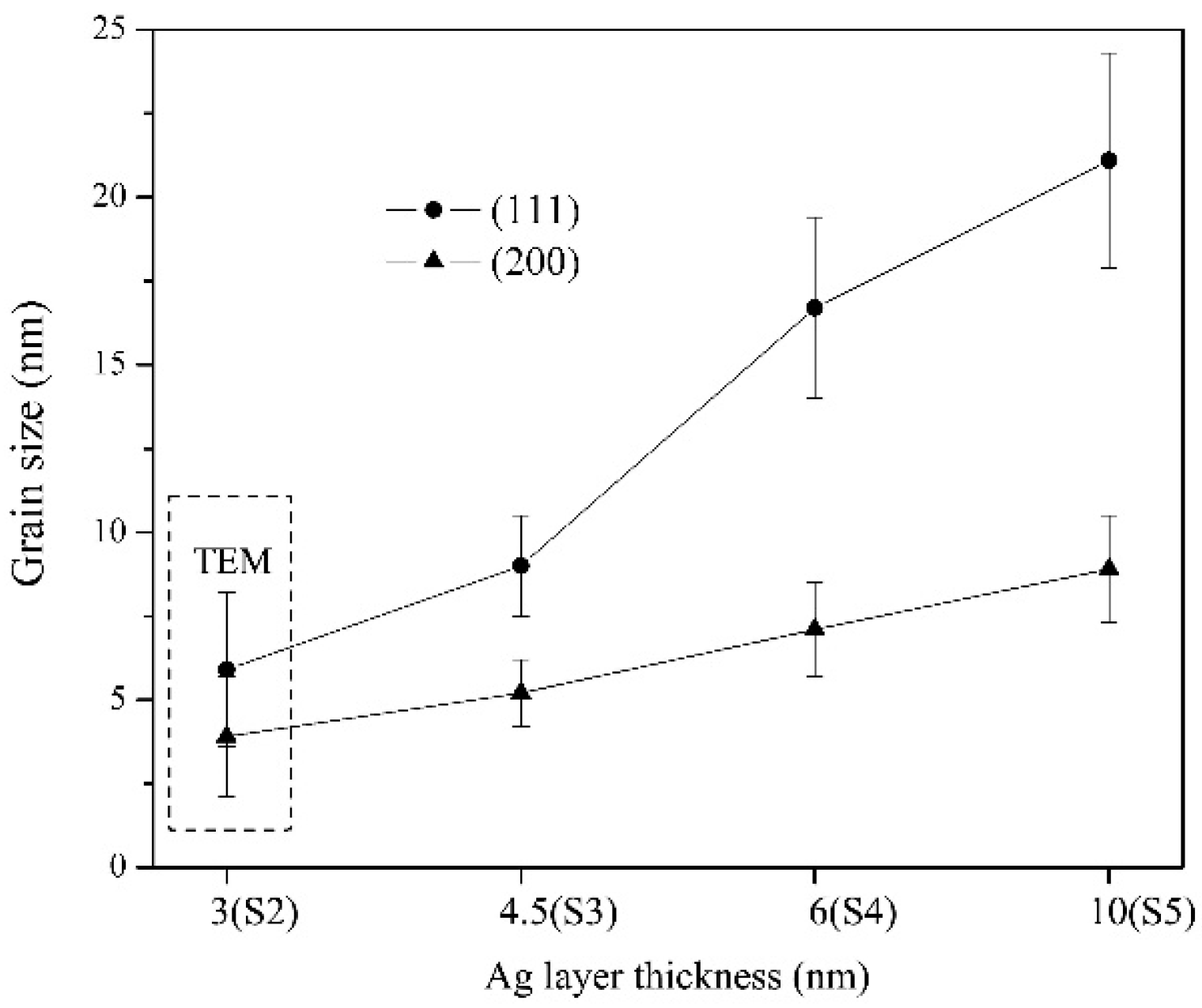

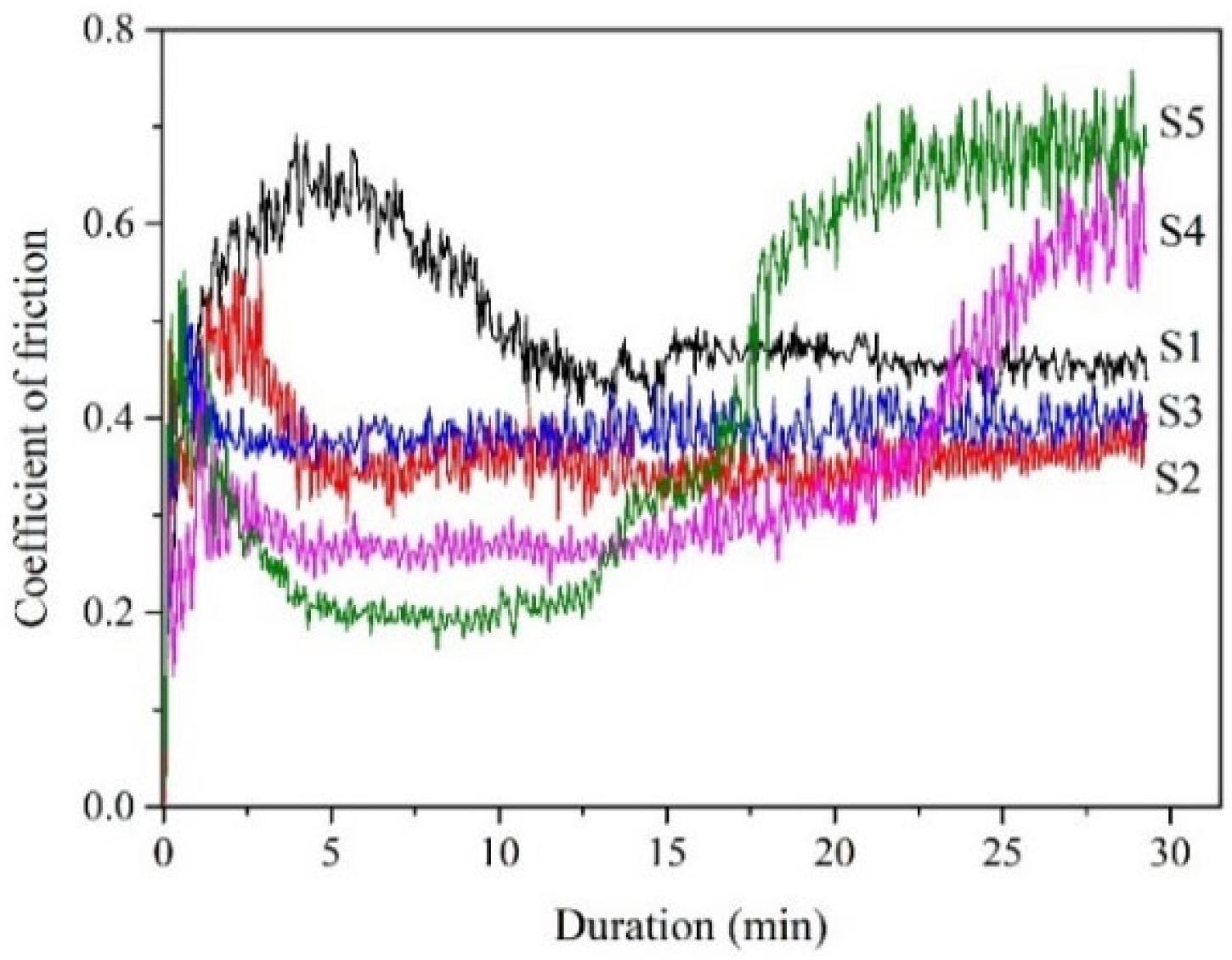
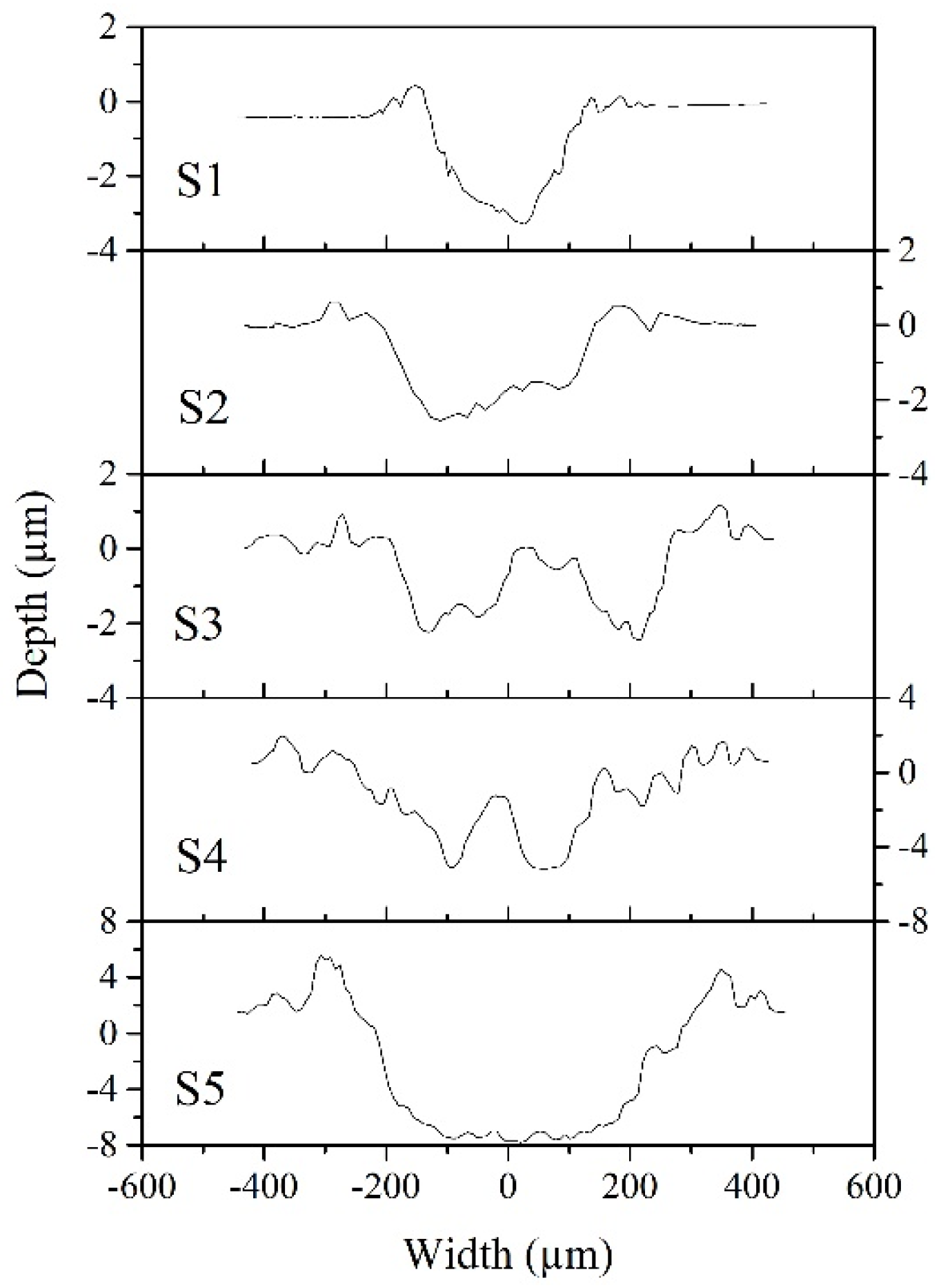
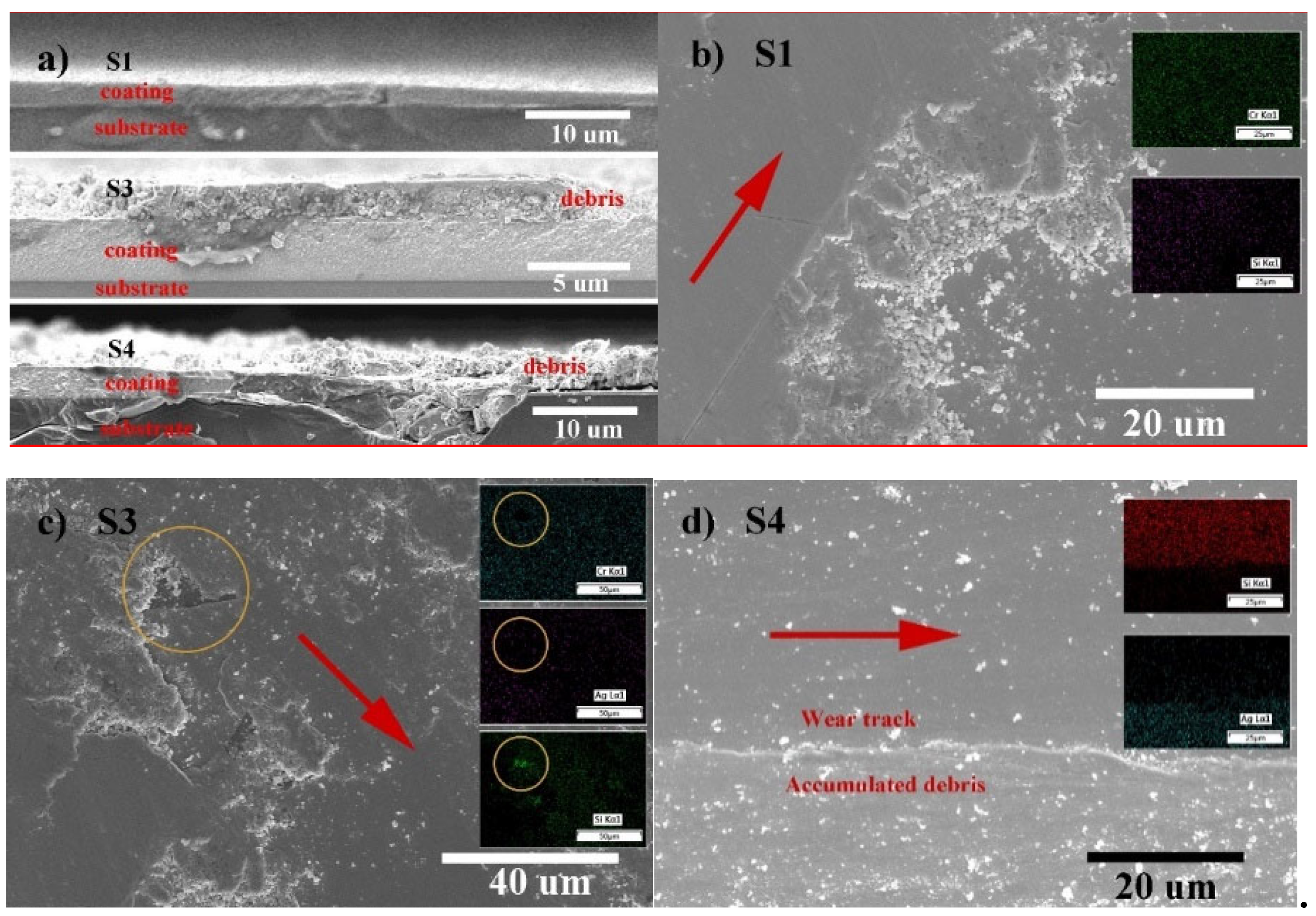
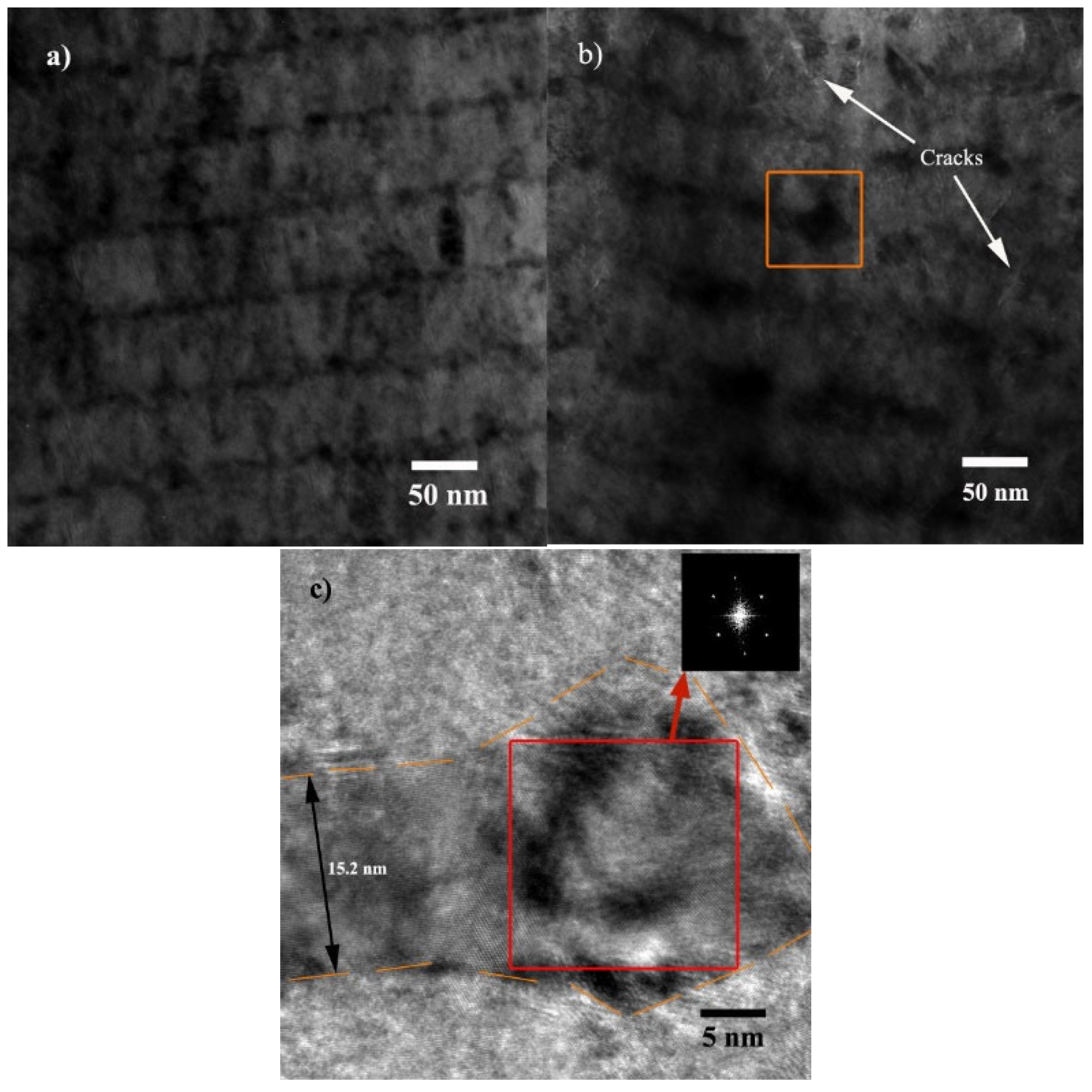
| Sample | Ag Target Power Density (W/cm2) | Average Layer Thickness (nm) | Periods Number | Film Thickness (µm) | Film Content (at.%) | |||
|---|---|---|---|---|---|---|---|---|
| Ag | CrNx | Cr | N | Ag | ||||
| S1 | 0 | 0 | – | – | 4.4 ± 0.3 | 67.2 | 32.8 | 0 |
| S2 | 0.65 | 3 | 60 | 65 | 4.1 ± 0.2 | 62.1 | 32.5 | 5.4 |
| S3 | 1 | 4.5 | 60 | 60 | 4 ± 0.2 | 61.7 | 31.2 | 7.1 |
| S4 | 1.3 | 6 | 60 | 55 | 3.8 ± 0.2 | 58.6 | 30.6 | 10.8 |
| S5 | 2 | 10 | 60 | 55 | 4 ± 0.2 | 54.2 | 28.7 | 17.1 |
© 2020 by the authors. Licensee MDPI, Basel, Switzerland. This article is an open access article distributed under the terms and conditions of the Creative Commons Attribution (CC BY) license (http://creativecommons.org/licenses/by/4.0/).
Share and Cite
Hong, C.; He, P.; Tian, J.; Chang, F.; Wu, J.; Zhang, P.; Dai, P. On the Microstructure and Mechanical Properties of CrNx/Ag Multilayer Films Prepared by Magnetron Sputtering. Materials 2020, 13, 1316. https://doi.org/10.3390/ma13061316
Hong C, He P, Tian J, Chang F, Wu J, Zhang P, Dai P. On the Microstructure and Mechanical Properties of CrNx/Ag Multilayer Films Prepared by Magnetron Sputtering. Materials. 2020; 13(6):1316. https://doi.org/10.3390/ma13061316
Chicago/Turabian StyleHong, Chunfu, Ping He, Jun Tian, Fa Chang, Jianbo Wu, Pingshan Zhang, and Pinqiang Dai. 2020. "On the Microstructure and Mechanical Properties of CrNx/Ag Multilayer Films Prepared by Magnetron Sputtering" Materials 13, no. 6: 1316. https://doi.org/10.3390/ma13061316
APA StyleHong, C., He, P., Tian, J., Chang, F., Wu, J., Zhang, P., & Dai, P. (2020). On the Microstructure and Mechanical Properties of CrNx/Ag Multilayer Films Prepared by Magnetron Sputtering. Materials, 13(6), 1316. https://doi.org/10.3390/ma13061316




